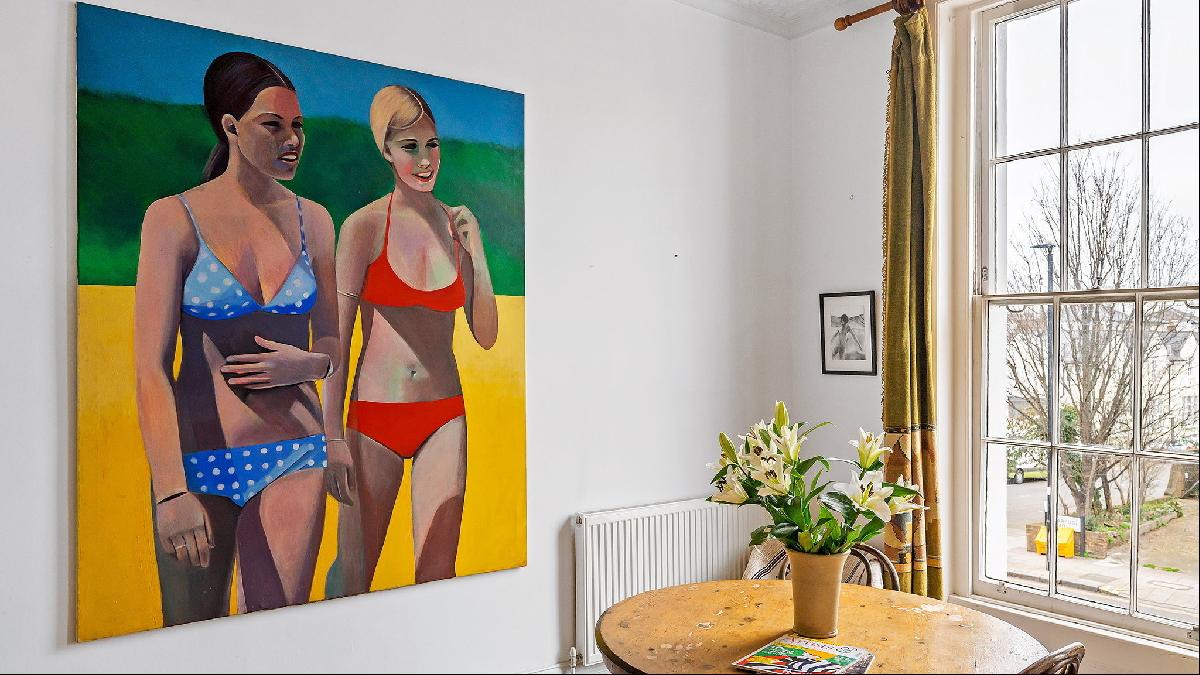
By Thea Hawlin
The Grade II-listed Georgian house in Islington, north London, where the late British artist Sue Dunkley resided for over 50 years, still carries her creative legacy. Vibrant canvases depicting figures, domestic scenes, and abstract landscapes adorn the walls of the three-bedroom home, now available for purchase at £2.1 million. The floors of Dunkley’s former studio on the ground floor bear paint splatters, a testament to her artistic process that her daughter, playwright Jane Bodie, couldn’t bring herself to remove.
Bodie fondly remembers growing up in a house that doubled as a gallery space during the 1960s and 1970s. Notable guests, including Pink Floyd, artists Phyllida Barlow and Howard Hodgkin, and poet Seamus Heaney, graced its rooms. Bodie affectionately describes her household as a place where eloquent conversations flourished, with her own decision to become a playwright driven, in part, by the desire to have uninterrupted dialogue.

Constructed in 1834, this four-storey mid-terrace house has been meticulously preserved, retaining its original characteristics such as large sash windows, fireplaces, and mouldings. Dunkley playfully referred to it as her “history house,” humorously pointing out that nearby hangings were still occurring when it was built. Nevertheless, it also served as Dunkley’s haven, encapsulating her entire personal history, according to Bodie.
Returning home from school, Bodie and her brother were met with two possibilities: either the house would be filled with guests, listening to the likes of Billie Holiday and Nina Simone, or the studio door would be closed, indicating their mother’s unwavering commitment to her work. Just like Dunkley’s favorite colors of orange and blue, these contrasting states harmoniously coexisted. Bodie reflects, “Blue to me has a sadness and orange has a vibrancy, and that’s quite a good description of mum. She had two distinct moods: she could be incredibly vibrant and the life and soul, or she was on her own, working.”

Orange and blue were constants in the house’s interior decoration. The iconic blue front door, now repainted by Bodie, originated when Dunkley moved into the house in 1966 with her then-husband, Don Bodie. Don, a musician who had toured with Dire Straits, was also a skilled restorer and builder, often bringing unique pieces of furniture to the house. One such item is the large apothecary chest in the kitchen, salvaged from a nearby pharmacy.
Bodie remembers her mother’s meticulous attention to color, dyeing their bedsheets to avoid the sadness associated with white. Pots were carefully arranged in the window, and towels were hung with precision, mirroring the ordered aesthetic of a Mondrian window. In contrast, Dunkley’s art, once bold and vivid, evolved into smaller, muted tones, featuring delicate pastel depictions of women gazing out of windows.

Even after her children grew up, Dunkley continued her artistic pursuits, working as an art adviser in the 1992 film “The Railway Station Man,” featuring Julie Christie and John Lynch. Inspired by the paintings she created for Christie’s artist character, Dunkley entered an era of atmospheric landscapes. Bodie marvels at her mother’s unyielding dedication, stating, “What’s amazing to me is that she worked continually like a Trojan. Even when she had periods where her work wasn’t fashionable, she was never not working.”
Dunkley’s painting ceased only when she was diagnosed with dementia. In 2016, her children organized an exhibition at the house to raise funds for her care, with each floor dedicated to a different period of her work. Bodie describes the event as a bittersweet celebration in her mother’s absence.
Following Dunkley’s passing in August, it was decided that her estate’s artworks would be managed by The Mayor Gallery on Cork Street in London. An exhibition is scheduled for September this year. While letting go of their cherished home, Bodie and her brother embrace the opportunity for her mother’s art, and now her house, to embark on a new chapter.
Photography: Savills
Denial of responsibility! VigourTimes is an automatic aggregator of Global media. In each content, the hyperlink to the primary source is specified. All trademarks belong to their rightful owners, and all materials to their authors. For any complaint, please reach us at – [email protected]. We will take necessary action within 24 hours.

